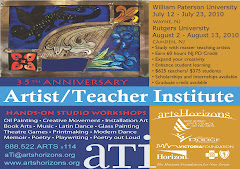Special Education Teacher, Mercer County
Instructor and Vision Consultant, New Jersey Commission for the Blind and Visually Impaired
Laura Christensen Tunis has been an Instructor and Vision Consultant with the New Jersey Commission for the Blind and Visually Impaired since 1987. She earned her BA in Art Education from The College of NJ and is NJ certified in art, special education and teacher of the visually impaired. She has studied extensively with well-known artists at Penland-(NC) Haystack-(ME) Arrowmont-(TN) and Brookfield Craft Centers-(CT). She is a talented fiber artist, bead and crafts designer who believes in providing quality arts education for students with disabilities. Laura has sold her work through local craft shows, shops and galleries. Laura is a practicing artist who enjoys working in mixed media, book making, beading and gourd crafting. She is currently assigned to work with students ages 3-21 in the Mercer County area. She has been teaching to all ages for over 20 years after becoming disenchanted with an "Art on a Cart" elementary art teaching experience.
What exactly does a teacher of the visually impaired do?
A teacher of blind and visually impaired serves as a consultant to classroom teachers and helps to select appropriate methods and materials. The teacher of the blind assists teachers by explaining the types of objects students are able to see and under what conditions.
In addition, these specialists deal with instructional problems related to the teaching of specific lessons and concepts. Teachers of the blind also adapt materials and lessons; provide text in Braille and large print; and teach specialized skills such as the use of computer programs that produce voice output or Braille translations of text. Teachers of the blind also work directly with students when they teach Braille and specific skills needed by their students. Each day is different and brings new challenges!
"Having been an art teacher, I recognize the importance of interacting and collaborating with other art teachers to gain insight about successful learning environments they have established. Many visually impaired children are mainstreamed into regular education classrooms and work along with their sighted peers with the assistance of adapted materials. Some subjects, such as art, are more difficult than others to adapt or modify. Children need to be encouraged to express and communicate their own ideas, thoughts and feelings through creative activities. Whether you teach in a special-education program or in a "regular" classroom, sooner or later you will encounter special kids facing special challenges. More information and resources will help teachers better understand (and help) students with special needs. I want to be a part of this exciting aTimpact fellows opportunity!"
Click on any category below to see aTi Best Practices you can use in your classroom.
Subscribe to:
Post Comments (Atom)







No comments:
Post a Comment